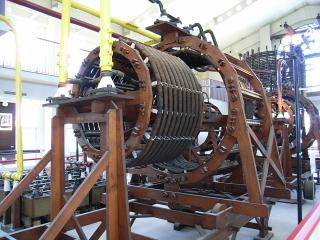Since the Meiji Revolution, Japan has depended on submarine cables owned by European and American telegraph companies for its communications with foreign countries. It was disadvantageous, however, for Japan, both in diplomatic and in commercial terms, to be dependent in this way upon foreign-owned communications systems. Given this historical backdrop, to compensate for the problems associated with submarine cables, and to maintain its autonomy in communications, Japan embarked on an all-out research effort toward the development of the new wireless telecommunications technologies. It was believed at that time that long-distance communications required increased electric power and the use of Low Frequency.
In 1925, a bill to establish the Nihon Musen Denshin Denwa KK (Japan Wireless Telegraph and Telephone Co., Ltd.) made its way through the Japanese parliament, converting the telegraph and telephone industry from government to semi-private management. At that point, plans were formulated for the Europe-oriented Yosami Radio Transmitting Station. Construction of the station, which was originally designed to be a high-powered low frequency transmitting station, began in July 1927 and was completed in 1929, at which point regular operations began. As it turned out, however, it was found that High Frequency (shortwave), low power communications with comparatively lower power were effective over long distances. This marked the start of the significantly expanded use of shortwave in international communications. Nevertheless, scientists and engineers also realized that only high power low frequency transmissions could reach every corner of the globe, and transmissions using Low Frequency were only as a special telecommunications solution.


After the World War Ⅱ, the United States acquired the Yosami facility for its own use. By 1993, the US announced that the station would be shut down. In August 1994, the station fully reverted to Japanese ownership, and plans were drafted to remove the equipment. Work began in November 1995 to dismantle the antenna and the coil house. Work on dismantling the 8 towers began in July 1996. The task of removing the station was completed in March 1997, and with that the mission of the Yosami Radio Station had reached its end.



History of the Yosami Radio Transmitting Station Recognized as IEEE Milestone
The wireless broadcasting facility that was used at the former Yosami Radio Transmitting Station is currently on display in the Yosami Radio Transmitting Station Memorial Hall in the Floral Garden Yosami in Kariya City, Aichi Prefecture. On May 19, 2009 this wireless transmitting facility was recognized as an IEEE Milestone. The IEEE (the Institute of Electrical and Electronics Engineers) Milestones award program, which was started in 1983, recognizes inventions and technical innovations that represent significant contributions to society in the electrical, electronics, and other related technical fields. As of 2009, over 80 such achievements have been recognized worldwide, and the wireless transmitting equipment that was used in the former Yosami Radio Transmitting Station is the ninth Milestone award in Japan.


Memorial Hall



and AC generator (background)
